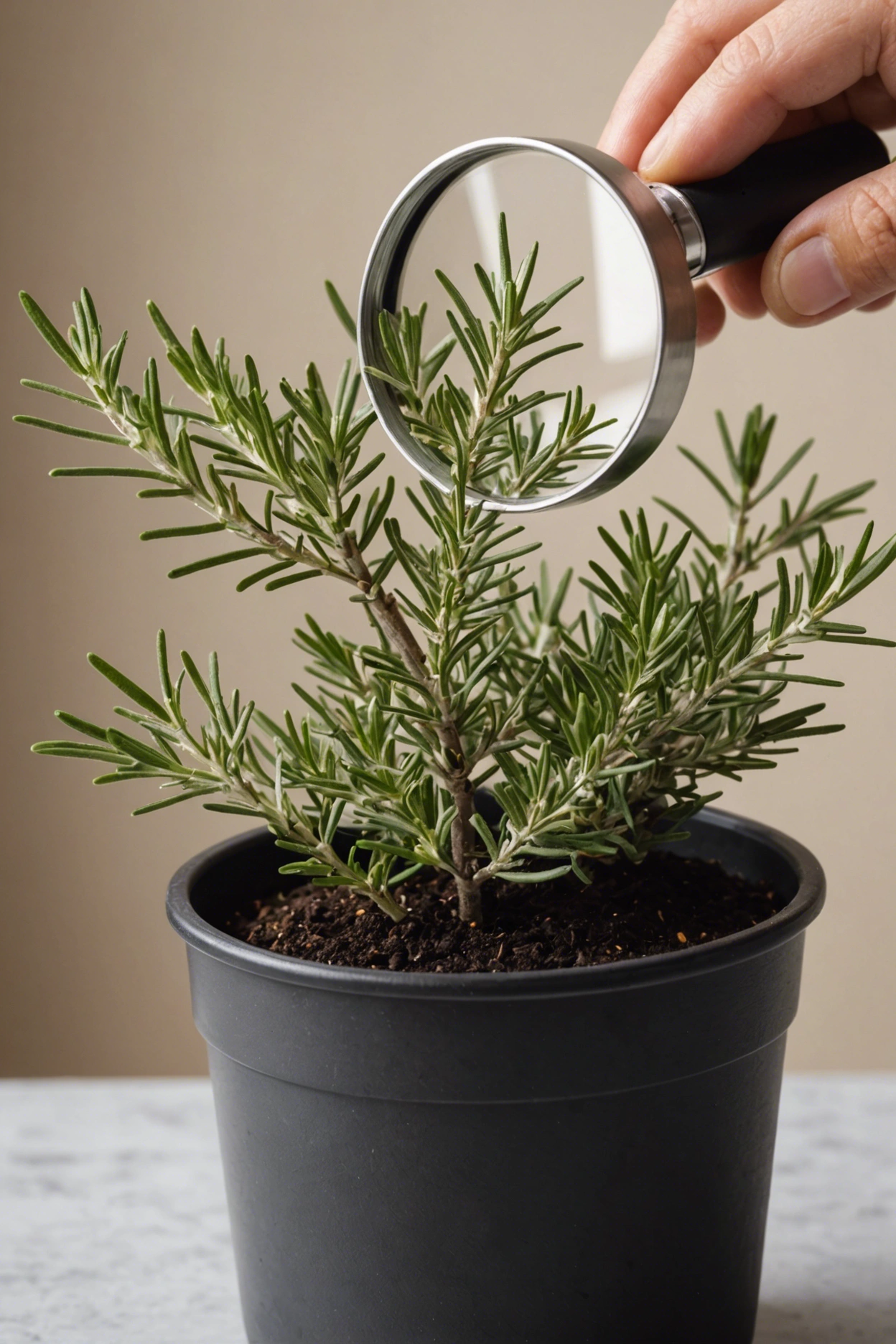Did you know that Rosemary is not just a culinary superstar but also a hardy and resilient plant? But even the toughest plants have their off days. If you’ve been noticing your Rosemary Turning Yellow, don’t panic yet.
It’s quite common for these aromatic perennials to show signs of distress, and yellowing leaves are one of them. This could be due to various reasons ranging from watering issues, soil conditions, or even pest attacks.
But worry not! With a little patience and care, you can get your rosemary back in its prime. Keep reading about Rosemary Turning Yellow and discover how to diagnose and treat this common issue effectively.
Quick Answer
- Watering issues: Overwatering or underwatering can cause your rosemary to turn yellow. It likes to be a bit dry, so don’t drown it!
- Soil conditions and nutrient deficiencies: Rosemary prefers well-drained soil with a pH between 6.0 and 7.0. If it’s not getting enough iron or nitrogen, it might start looking yellow.
- Environmental stress factors: Too much sun, too little sun, too hot, too cold – rosemary can be a bit of a Goldilocks when it comes to its environment.
- Diseases and pests: Watch out for root rot and aphids! They love munching on your rosemary and can cause yellowing.
- To fix the problem, you’ll need to diagnose the issue (check water levels, test soil pH) then take steps to revive your plant (adjust watering schedule, amend soil).

What Causes Rosemary to Turn Yellow?
There are a few sneaky culprits behind your rosemary plant turning yellow. Let’s dive in and uncover them.
Watering Issues
When it comes to rosemary plant care, getting the watering right is like hitting the jackpot. Too much water? Your plant’s roots can’t breathe, leading to yellow leaves. This is what we call overwatered rosemary symptoms. On the flip side, not enough water makes your rosemary thirsty, showing off those pale, yellow leaves as a cry for help—classic underwatered rosemary signs.
To strike gold with watering, check the soil before you pour. If it’s damp, hold off on watering; if dry, it’s time for a drink. Remember, your rosemary doesn’t want to swim; it just wants to stay hydrated.
Soil Conditions and Nutrient Deficiencies
Rosemary thrives in its happy place with well-draining soil and just the right nutrients. If the soil feels more like a swamp or hard as a rock, you’ve got trouble. Poor soil doesn’t let roots breathe or drink properly—hello, yellow leaves!
For an A+ in rosemary soil requirements, aim for sandy loam that lets water through but keeps roots cozy. And don’t forget about food! Lack of nutrients like nitrogen can turn your rosemary sad and yellow. A little compost or fertilizer can go a long way.
Environmental Stress Factors
Think of your rosemary as Goldilocks—not too hot, not too cold. Extreme temperature swings make rosemary plants throw a fit with yellow leaves. And light? It’s all about finding that sweet spot.
Too much direct sun scorches leaves, while not enough leaves them craving sunlight and turning yellow out of spite. Aim for that perfect balance of bright but indirect light where your rosemary can bask without getting burnt.
Diseases and Pests
Just when you thought you had it all figured out, along come uninvited guests: pests and diseases wreaking havoc on your rosemary plant‘s health. From sap-sucking insects to fungal foes, these villains love turning vibrant green leaves into sickly yellow ones.
The best defense is a good offense—keep an eye out for early signs of trouble like spots or bugs on the underside of leaves. Catching these party crashers early means you can show them the door before they do too much damage.
How to Diagnose Yellowing in Rosemary Plants
Getting to the bottom of why your rosemary is turning yellow is like playing detective. You’ll need to do a visual inspection and maybe even some soil testing.
Visual Inspection for Common Symptoms
When you first notice those yellow leaves, don’t panic! Start with a good, old-fashioned visual plant inspection. Look closely at your rosemary. Are the yellow leaves at the bottom or all over? This clue can tell you a lot. Bottom leaves turning yellow might just mean your plant needs more water or less sun. But if the whole plant is yellow, it could be a sign of something more serious.
Next, check for bugs. Yes, tiny critters love munching on rosemary too. If you see any bugs hanging around, that might be your problem. Also, look for weird spots or patterns on the leaves. These can be signs of disease.
Remember, spotting these issues early can save your plant’s life. So put on your detective hat and keep an eye out for these signs of unhealthy rosemary.
Testing Soil pH and Moisture Levels
Now let’s talk dirt – literally. Your rosemary’s soil is like its home, and sometimes homes need checks to ensure they’re still good places to live. Testing the soil’s pH and moisture levels is like doing a home inspection for your plant.
Rosemary loves slightly acidic to neutral soil (pH 6-7). If the pH is off, your plant might not be able to eat properly – yes, plants “eat” nutrients from the soil! You can grab a pH test kit from most garden stores or online.
Moisture is another big deal. Rosemary doesn’t like wet feet; too much water can make it turn yellow and drop leaves as if saying, “I’m drowning here!” Stick your finger into the soil up to the second knuckle; if it feels wet, hold off on watering for a bit.
By keeping an eye on these two things – soil conditions for rosemary like pH and moisture – you’re giving your plant a fighting chance against turning yellow. It’s all about creating the perfect home environment for it to thrive in.



Step by Step Guide to Reviving Yellowing Rosemary


Reviving a yellowing rosemary plant might seem like a daunting task, but fear not! With the right steps, your fragrant herb can bounce back to its lush, green glory. Let’s break down the process into simple, actionable steps that will help breathe new life into your rosemary.
-
Check the soil moisture: First things first, poke your finger about an inch into the soil near your rosemary plant. If it feels dry, it’s time for a drink. However, if the soil is soggy or very wet, you’ve likely been overwatering. Allow the soil to dry out before watering again.
-
Ensure proper drainage: Rosemary hates wet feet! Make sure your pot has holes at the bottom. If not, consider repotting it into one that does. For garden-planted rosemary, mix in some sand or gravel to improve soil drainage.
-
Move to a sunny spot: Rosemary loves sunlight—lots of it! Ensure your plant gets at least 6-8 hours of direct sunlight daily. If you’re growing indoors, a south-facing window is ideal.
-
Trim away dead parts: Using clean scissors or pruning shears, gently trim off any yellow or brown stems and leaves. This helps the plant focus its energy on healthy growth.
-
Adjust watering habits: Water only when the top inch of soil is dry to touch but do so thoroughly until water runs out of the drainage holes. Remember, less frequent but deep watering is key.
-
Feed with a balanced fertilizer: Give your rosemary a boost with a balanced liquid fertilizer every 4-6 weeks during its growing season (spring through fall). Avoid over-fertilizing as this can harm more than help.
-
Watch for pests: Sometimes pests like spider mites can cause yellowing leaves due to their feeding habits. Inspect under leaves and along stems for tiny critters or webbing and treat with insecticidal soap if needed.
-
Provide good air circulation: Especially if grown indoors, ensure there’s enough space around your rosemary for air to circulate freely which helps prevent fungal diseases that could cause yellowing.
By following these steps carefully and consistently monitoring your plant’s environment and needs, you’ll set up your rosemary for a successful revival from its yellow state back to vibrant health.
Preventative Measures for Healthy Rosemary Plants
Keeping your rosemary plant vibrant and green rather than yellow and sad is all about giving it what it loves most. Here’s how you can play superhero to your rosemary plants with some simple preventative measures.
-
Water wisely: Rosemary doesn’t like soggy feet! Make sure its soil drains well and let the top inch dry out before watering again. Overwatering is a no-no, so when in doubt, wait it out.
-
Let there be light: These plants are sun worshippers. Place them where they can bask in at least six to eight hours of sunlight daily. If your rosemary is indoors, a sunny windowsill is its best friend.
-
Feed carefully: Too much love in the form of fertilizer can harm your rosemary. Use a balanced, slow-release fertilizer but only sparingly. Sometimes, less really is more.
-
Prune with purpose: Regular trimming not only keeps your plant looking tidy but also encourages healthy growth. Don’t go overboard; just snip enough to maintain its shape and remove any dead or yellowing parts.
-
Watch the weather: If you’re growing rosemary outside, keep an eye on the temperature. These plants like it warm but not too hot. Provide some shade during extreme heat and consider bringing potted plants indoors during cold snaps.
-
Pest patrol: Keep an eye out for unwelcome visitors like aphids or spider mites that might stress your plant and cause yellowing. A gentle spray of water or insecticidal soap can help fend them off.
By sticking to these simple steps, you’re setting up your rosemary for a long, lush life free from the yellows. Remember, taking care of rosemary isn’t rocket science—it’s more like being a good plant parent who knows what their green baby needs!


Signs and Solutions for Common Rosemary Pests and Diseases
| Pest/Disease | Signs | Solutions |
|---|---|---|
| Aphids | Yellow, curled leaves; sticky residue on plant or nearby surfaces. | Use insecticidal soap or neem oil. Introduce beneficial insects like ladybugs. |
| Powdery Mildew | White, powdery substance on leaves and stems. | Improve air circulation around the plant. Apply a fungicide if necessary. |
| Root Rot | Yellowing and wilting of lower leaves; black, rotten roots. | Avoid overwatering. Ensure proper drainage in the pot or ground where the rosemary is planted. |
| Spider Mites | Tiny webbing on the plant; yellow or brown spots on leaves. | Use a strong stream of water to knock off mites. Apply miticide if infestation is severe. |
| Whiteflies | Small white insects on underside of leaves; yellowing leaves. | Use insecticidal soap or introduce beneficial insects like lacewings. |
| Botrytis Blight (Gray Mold) | Brown spots on leaves; gray, fuzzy mold on plant parts especially during high humidity conditions. | Remove affected parts immediately, improve air circulation around the plant and apply appropriate fungicides. |
| Downy Mildew | Yellow patches on top of leaves with corresponding grey, fuzzy growth underneath. | Apply a suitable fungicide and ensure good air circulation around plants. |


